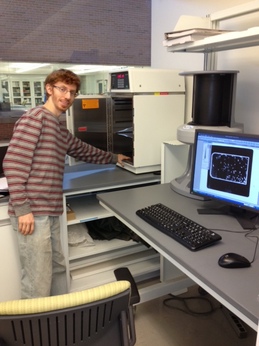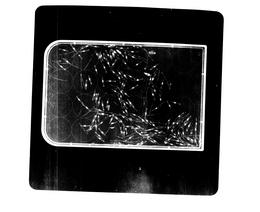|
|
David Lowenstein, a PhD student from University of Illinois at Chicago, came to the lab at the Chicago Botanic Garden in December to use our x-ray machine for his research project. One of the species he using in his project is Echinacea purpurea.

David x-raying a sample of Echinacea fruits (achenes).
Here’s what David had to say about his project…
I am studying pollinators in Chicago and whether vegetable crops and wild flowers in various neighborhoods in Chicago receive sufficient pollination. To investigate this, I used a mobile garden consisting of eggplant, cucumber, and purple coneflower. Potted plants of these species were transported to Chicago neighborhoods and left outside for four and half hours. I observed bee visits to focal plants, sampled the neighborhood floral community, and allowed the plants to mature under pollinator exclusion netting in the UIC greenhouse to measure pollination services. I measured pollination of purple coneflower by X-raying the achenes at the Chicago Botanic Garden and recording the proportion of full achenes from each Echinacea flowerhead. I found a positive relation between bee abundance and human population density, and I will use data from X-rayed achenes to determine if pollination services are also related to population density or other land cover variables. To read more about this project that will continue in summer 2013, visit http://www.uic.edu/labs/minor/urban_pollination.html
Here are three of his x-ray images. If you click & enlarge these images, you will see that some achenes are empty and others have embryos.



Mindy Runge & Ale Mendoza participated in a mini-internship in the Echinacea lab at the Chicago Botanic Garden this fall. They are in Lynn Westley’s Plant Biology class at Lake Forest College.
Mindy & Ale investigated seed set in Echinacea heads from a prairie remnant in western Minnesota. They compared seed set in tops and bottoms of heads (florets at the bottom of a head flower first). In the process of answering their question, they learned how to dissect achenes from Echinacea seed heads, how to operate our high-tech seed balance, and how to organize datasets.

Ale and Mindy dissecting seedheads
Lydia mapped many Echinacea plants in two remnants: eelr and alf. Here is a list of distances in meters between all pairs of plants.
distancesForLydia.RData
This version of Lydia’s R script will read her dataset and edit it and then read the distances and merge them to her compatibility dataset.
mergeScriptForLydia.R
We delayed our fieldwork for a few minutes this morning because of scattered showers. Who knew we should have delayed for a few more minutes because of Solar X-Ray Flux?
The National Weather Service’s weather radar indicated that the rain (aka atmospheric H2O flux) was mostly south of us, so we knew it would be a short delay. However, we should have checked NOAA’s space weather forecast…
When we arrived at the site, the atmospheric weather was OK, but the space weather was poor and our gps machine, Sulu (a Topcon GRS1), had a difficult time getting oriented. It may have been groggy because of the burst of solar X-Ray Flux. Here is the graph of Solar x-ray Flux from NOAA:

Just our luck! Next time we’ll check our local weather forecast and the space weather forecast!
Here is Sebastian Di Clemente’s final report on the main project of his internship:
If you are heading to ESA, visit Callin Switzer’s poster “Inspiring future ESA members in elementary or middle school, using place-based inquiry.”
It has been scheduled for:
Contributed Poster Session: Education: Pedagogy
Date: Tuesday, August 7, 2012
Time Slot: 4:30 PM – 6:30 PM
Location: Exhibit Hall DE at the 2012 ESA Annual Meeting, to be held in Portland, Oregon, August 5-10, 2012.
Visit his poster, #35507!
What’s this in plug 156? A young seedling with fused cotyledons and a true leaf just peeping up. in the nearby corner is a more typical seedling. Both plants come from florets of Echinacea angustifolia that were pollinated with pollen from Echinacea pallida.

Click image to embiggen!
In a paper just published in Restoration Ecology, Echinacea Project researchers report that establishing Echinacea angustifolia in existing prairie restorations and abandoned agricultural fields requires more than 20 seeds for each plant that germinates and survives to flowering. Plants start flowering about 10 years after sowing. Also, burning the prairie before broadcasting seeds helps emergence and survival.
Wagenius, S., A. B. Dykstra, C. E. Ridley, and R. G. Shaw. 2012. Seedling recruitment in the long-lived perennial, Echinacea angustifolia: a 10-year experiment. Restoration Ecology 20: 352-359. Available here: https://echinaceaproject.org/pub/wageniusEtAl2012.pdf
The Echinacea Project posted a job description for a postdoctoral position and details about how to apply. Applications will be reviewed starting 19 March 2012 and will be accepted until positions are filled. Learn more.
The Echinacea Project posted job descriptions for field research internships for summer 2012 along with details about how to apply. Applications will be reviewed starting 29 February 29, 2012 and will be accepted until positions are filled.
The text of an ad to be distributed is copied here…
Are you interested in gaining field research experience and learning about the ecology and evolution of plants and plant-animal interactions in fragmented prairie? We are looking for 3-5 summer field researchers for an NSF-funded project on habitat fragmentation of the tallgrass prairie. We are investigating how small plant population size influences inbreeding, demography, pollination, and herbivory in the purple coneflower, Echinacea angustifolia. This is a great summer internship, REU, or co-op for those interested in field biology or conservation research.
No experience is necessary, but you must be enthusiastic and hard-working. You will survey natural plant populations, measure plant traits in experimental plots, hand-pollinate plants, observe & collect insects, and assist in all aspects of research. Housing is provided and there is a stipend. Undergraduate students have the opportunity to do an independent project as an REU participant.
|
|







